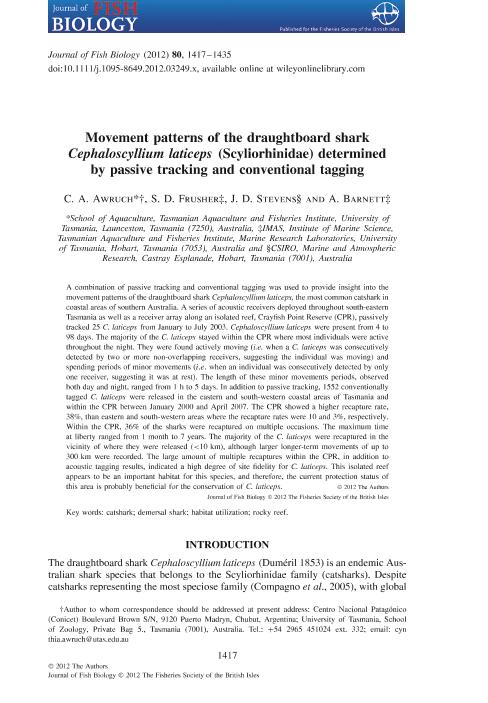Mostrar el registro sencillo del ítem
dc.contributor.author
Awruch, Cynthia Andrea

dc.contributor.author
Frusher, S. D.
dc.contributor.author
Stevens, J. D.
dc.contributor.author
Barnett, A.
dc.date.available
2019-05-20T20:39:13Z
dc.date.issued
2012-04
dc.identifier.citation
Awruch, Cynthia Andrea; Frusher, S. D.; Stevens, J. D.; Barnett, A.; Movement patterns of the draughtboard shark Cephaloscyllium laticeps (Scyliorhinidae) determined by passive tracking and conventional tagging; Wiley Blackwell Publishing, Inc; Journal of Fish Biology; 80; 5; 4-2012; 1417-1435
dc.identifier.issn
0022-1112
dc.identifier.uri
http://hdl.handle.net/11336/76746
dc.description.abstract
A combination of passive tracking and conventional tagging was used to provide insight into the movement patterns of the draughtboard shark Cephaloscyllium laticeps, the most common catshark in coastal areas of southern Australia. A series of acoustic receivers deployed throughout south-eastern Tasmania as well as a receiver array along an isolated reef, Crayfish Point Reserve (CPR), passively tracked 25 C. laticeps from January to July 2003. Cephaloscyllium laticeps were present from 4 to 98 days. The majority of the C. laticeps stayed within the CPR where most individuals were active throughout the night. They were found actively moving (i.e. when a C. laticeps was consecutively detected by two or more non-overlapping receivers, suggesting the individual was moving) and spending periods of minor movements (i.e. when an individual was consecutively detected by only one receiver, suggesting it was at rest). The length of these minor movements periods, observed both day and night, ranged from 1 h to 5 days. In addition to passive tracking, 1552 conventionally tagged C. laticeps were released in the eastern and south-western coastal areas of Tasmania and within the CPR between January 2000 and April 2007. The CPR showed a higher recapture rate, 38%, than eastern and south-western areas where the recapture rates were 10 and 3%, respectively. Within the CPR, 36% of the sharks were recaptured on multiple occasions. The maximum time at liberty ranged from 1 month to 7 years. The majority of the C. laticeps were recaptured in the vicinity of where they were released (<10 km), although larger longer-term movements of up to 300 km were recorded. The large amount of multiple recaptures within the CPR, in addition to acoustic tagging results, indicated a high degree of site fidelity for C. laticeps. This isolated reef appears to be an important habitat for this species, and therefore, the current protection status of this area is probably beneficial for the conservation of C. laticeps.
dc.format
application/pdf
dc.language.iso
eng
dc.publisher
Wiley Blackwell Publishing, Inc

dc.rights
info:eu-repo/semantics/openAccess
dc.rights.uri
https://creativecommons.org/licenses/by-nc-sa/2.5/ar/
dc.subject
Catshark
dc.subject
Demersal Shark
dc.subject
Habitat Utilization
dc.subject
Rocky Reef
dc.subject.classification
Otras Ciencias Biológicas

dc.subject.classification
Ciencias Biológicas

dc.subject.classification
CIENCIAS NATURALES Y EXACTAS

dc.title
Movement patterns of the draughtboard shark Cephaloscyllium laticeps (Scyliorhinidae) determined by passive tracking and conventional tagging
dc.type
info:eu-repo/semantics/article
dc.type
info:ar-repo/semantics/artículo
dc.type
info:eu-repo/semantics/publishedVersion
dc.date.updated
2019-03-08T16:43:40Z
dc.identifier.eissn
1095-8649
dc.journal.volume
80
dc.journal.number
5
dc.journal.pagination
1417-1435
dc.journal.pais
Reino Unido

dc.journal.ciudad
Londres
dc.description.fil
Fil: Awruch, Cynthia Andrea. Consejo Nacional de Investigaciones Científicas y Técnicas. Centro Científico Tecnológico Conicet - Centro Nacional Patagónico; Argentina. University of Tasmania; Australia
dc.description.fil
Fil: Frusher, S. D.. University of Tasmania; Australia
dc.description.fil
Fil: Stevens, J. D.. Commonwealth Scientific And Industrial Research Organization; Australia
dc.description.fil
Fil: Barnett, A.. University of Tasmania; Australia
dc.journal.title
Journal of Fish Biology

dc.relation.alternativeid
info:eu-repo/semantics/altIdentifier/url/https://onlinelibrary.wiley.com/doi/abs/10.1111/j.1095-8649.2012.03249.x
dc.relation.alternativeid
info:eu-repo/semantics/altIdentifier/doi/http://dx.doi.org/10.1111/j.1095-8649.2012.03249.x
Archivos asociados
